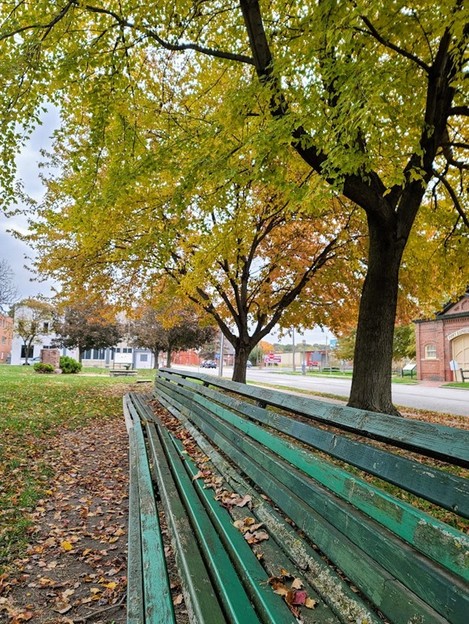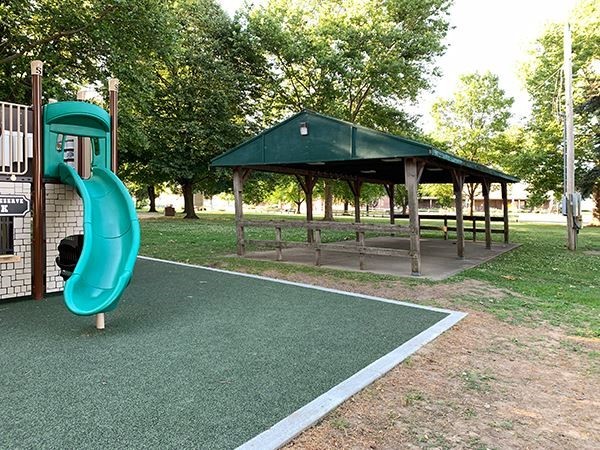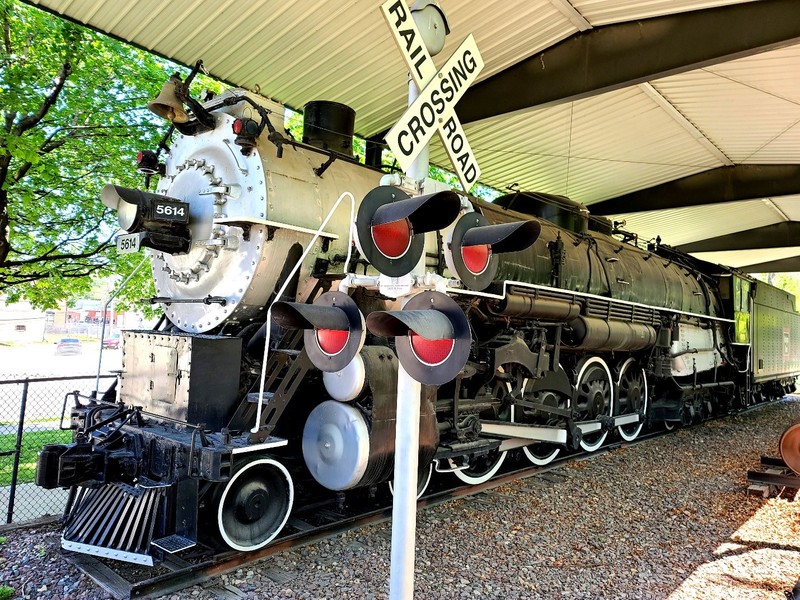Patee Park
Introduction
Text-to-speech Audio
Patee Park is a one-block park framed by Seneca, Penn, 9th, and 10th streets. It is well known to the residents of Saint Joseph as the annual venue for PumpkinFest—a fundraising family arts festival hosted by the Pony Express National Museum which features food, live entertainment, craft vendors, and, of course, Pumpkin Mountain. Although the physical footprint of the park is small compared to Saint Joseph’s much larger parks such as Krug or Hyde, it would nevertheless be difficult to understate the significance of Patee Park in shaping Saint Joseph’s community and history. From the Pony Express to PumpkinFest, Patee Park has existed as a launchpad for connecting people, near and far, for well over 160 years.
Images
Located just across from the Pony Express Stables, Patee Park is a lovely green space

There is a play area and picnic spaces

The train harkens back to the importance of the railroads in St. Joseph history

Backstory and Context
Text-to-speech Audio
Patee Park got an early start in Saint Joseph’s history after being donated to the city by one of its founders, John Patee, on December 8, 1855. Together with Smith Park, Patee Park has been described as the “nucleus” of the present parks system in Saint Joseph. Indeed, combining the age and location of the park, it becomes easy to see why it has become the anchor that it is today.
Patee Park is located across the street from one of Saint Joseph’s most treasured artifacts—the original Pony Express stables which is now the home of the Pony Express National Museum. The Pony Express’ first westbound rider, Johnny Fry, would have therefore begun his 90-mile contribution to the famed 10-day mail delivery route with an infant Patee Park and its original stand of cottonwood trees as his backdrop as he departed on April 3, 1860. The significance of this connection is echoed not only by the park’s monument dedicated to the Pony Express legacy (erected on April 3, 1913), but also by how the park has developed and been used in the years since.
Park commission chair D.M. Reichard led the initial development of Patee Park beginning in 1884. This development was initially met with opposition to the felling of healthy cottonwood trees. By 1889 however, the park boasted both its first fountain and commanded the esteem of nearby residents, with one area resident sharing their opinion in the Saint Joseph Harold, noting “in all the history of Patee Park it has never looked so well as it does at the present time.”
The aesthetic of Patee Park continued to evolve as Saint Joseph moved into the 20th century. In 1918, it received walkways and a new fountain. The most striking feature of Patee Park and another symbol of Saint Joseph’s enduring status as a western gateway, Engine 5614, did not arrive until May of 1962. This 4-8-4 locomotive, donated by the Chicago, Burlington, and Quincy Railroad, has survived days of its active passenger and freight service by a helping hand and grassroots care from a mobilized community. These efforts began as early as 1976, with both the Saint Joseph News Press and Gazette providing coverage of the restoration. With donations of time, materials, and labor, Engine 5614 was cleaned, repainted, and given a fresh look with new glass for its lights and windows.
Attention to Patee Park’s economic and cultural significance was called upon again, from 1985-1986, when a park beautification initiative was spearheaded by the Pony Express Neighborhood Network (PENN). The restoration work brought further amenities to Patee, including new playground equipment, refurbished picnic sites, fountain repairs, and the gazebo which, today, is host to entertainment during many of the Pony Express Museum’s events and festivals. Echoing the nuclear sentiments from 40 years prior, members of PENN viewed Patee as central to the impression the city would leave on its visitors. Resident Carles St. Clair spoke directly to the heart of this significance, writing “nearly 30,000 visitors a year stop at the Pony Express Stables across the street. If they see a city park, they see Patee.” Indeed, in 2023 alone, the Pony Express National Museum drew visitors not only regionally and nationally, but from as far away as Canada, Chile, Frace, Germany, and Sweden.
The attention garnered by Patee Park has not always resulted in efforts to improve or add to the park. In 1987, a representative from what would later become the Belton, Grandview and Kansas City Railroad Museum sought to remove Engine 5614 for their own collection. Although this proposition was rejected by the City of Saint Joseph with a recommendation from then interim Parks Director Bill McKinney and additional community feedback, it highlighted a very real need to consider Patee Park’s sustained challenges in addition to its heritage.
Throughout its lifespan, restoration work at Patee has been possible, in no small part, through the volunteer time, sweat, and collective efforts of a doting community. Much of the funding to maintain the park has come by way of community development grants or through fundraising efforts by private organizations and businesses. However, in the early 2000s, a crucial element for the long-term care of Engine 5614 was met when a volunteer group, Friends of the Park, and the Saint Joseph City Council reached an agreement to provide funding for the canopy which covers the locomotive today.
Patee Park has continued to evolve in more recent times. In 2019, Patee Park was one of six parks to receive new playground equipment. In keeping with the storied history of the park, this playground received a “wild west” theme, and was the only playground selected to receive such a unique façade.
While the sights and features may continue to grow and change, Patee Park has stood continuously as a beloved spot by generations of Saint Joseph’s residents. If planning a visit in the area, either for the annual PumpkinFest or any of the other area events regularly hosted by the Pony Express National Museum, visitors are invited to take in not only the wonderful amenities packed into this humble block, but to consider its rich history since 1855.
Sources
“Save the Trees”, St Joseph Gazette, February 16, 1884a.
“To the Editor of the Gazette”, St Joseph Gazette, February 16, 1884b.
“Work on Patee Park”, St Joseph Gazette, June 11, 1884c.
“About Patee Park”, St Joseph Herald, June 27, 1889.
“Timely Observations”, Saint Joseph News Press, May 15, 1947.
Bob Waldrop, “Locomotive in park to be renovated”, St Joseph Gazette, June 9, 1976.
“Locomotive renovation to start”, Saint Joseph News Press, June 12, 1976.
“Patee Park’s beauty to be restored”, St Joseph Gazette, September 15, 1986.
Steve Bennett, “City asked to give up park locomotive”, St Joseph Gazette, December 31, 1987.
“McKinney would keep park train”, Saint Joseph News Press, January 4, 1988.
Bob Waldrop, “Let’s rally around our old locomotive!”, St Joseph Gazette, February 15, 1988.
Beth Schlanker, “Touchup paint for the train”, Saint Joseph News Press, August 8, 2003.
Patty Scully, “Council will donate up to $15,000 to put roof over locomotive”, Saint Joseph News Press, May 11, 2004.
Jessica Stewart, “Balancing Act”, Saint Joseph News Press, July 18, 2004.
Jennifer Hall, “Community embraces the care of beloved train”, Saint Joseph News Press, December 25, 2017. https://www.newspressnow.com/news/local_news/community-embraces-the-care-of-beloved-train/article_81420b32-d389-5689-aea7-179dc7c0ad06.html
“Park News, Park History: Patee Park”, City Link, September 27, 2018.
Bredan Welch, “Unique playground comes to Patee Park”, Saint Joseph News Press, September 6, 2019.
“Historical Timeline”, Pony Express National Museum, n.d. https://www.ponyexpress.org/historical-timeline
“Annual Statistics”, Pony Express National Museum, n.d. https://www.ponyexpress.org/annual-statistics
